
April 21, 2023 – by John Blair, Valley Watch President and webpage editor. John Blair was one of the founding members of Valley Watch, whose purpose is “to protect the public health and environment of the lower Ohio River valley.” This is his perspective on environmental health progress since the first EarthDay in 1970.
April 22 marks the 53rd anniversary of EarthDay. At a ripe young 23, I went to Butler University and watched a film (No Blade of Grass) that forever changed my life. I became an “environmentalist.” My first action was to stop throwing cigarette butts out of my car window.
I gathered as much information as possible about pollution, read The Limits to Growth and celebrated the passage of the Clean Water and Clean Air Acts, the Endangered Species Act, the Safe Drinking Water Act and, in 1976 the passage of the Toxic Substance Control Act. I also ran for Congress in 1976 and two of my main issues were high utility bills and seeking to stop a stupid idea to build another Wabash Canal. I lost the election but won the issue of the Canal with the help of Indiana Senator, Richard Lugar and common sense. 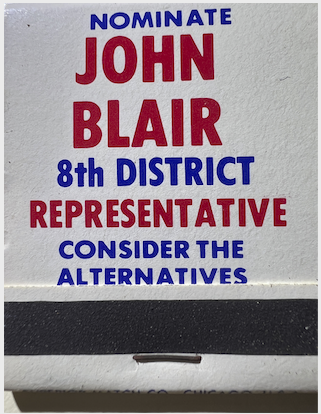
Winning that issue did embolden me and when I heard that the Feds were looking to build a nuclear waste dump in the Hoosier National Forest, I was driven to action, forming a rag tag group called the Nuclear Waste Action Committee. My first contact in that fight was the Evansville Chamber of Commerce, whom I figured would be readily on board since such a facility would not serve us well in attracting any sort of clean new business. They balked and I would soon find that they were not interested in quality of life issues at all, just jobs, often dangerous. NWAC played hardball and kept the nuclear waste site out of Indiana.
Around that same time, a massive buildout of coal fired power plants was taking place in the region as well as a huge Marble Hill nuclear plant that was proposed and being built on our drinking water source, the Ohio River, near Madison. Then, in the late 1970s three giant “synthetic fuel” plants, designed to convert local coal into other forms of coal were proposed just across the River between Owensboro and Henderson in Kentucky.
We were truly under assault from a variety of huge new pollution sources if they were successful.
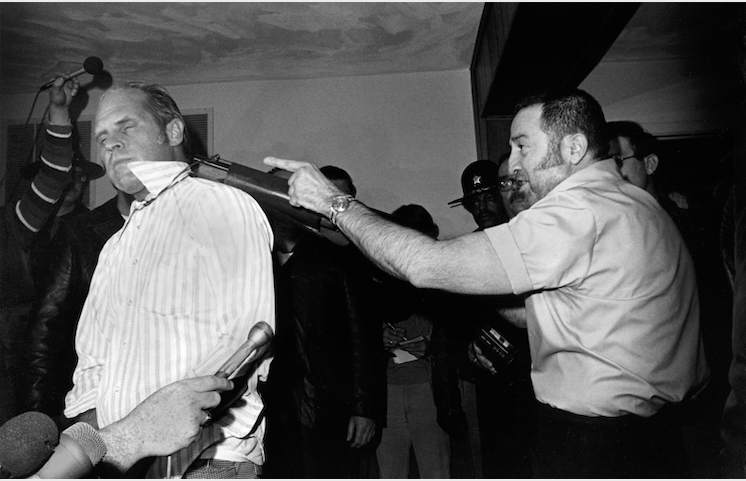
This picture won the Pulitzer Prize for New Photography in 1978. It shows and Indianapolis mortgage banker held at the end of pistol shotgun by a kidnapper. Winning such a prestigious award gave our nascent environmental health movement additional credibility. © 1977 John Blair
Then, four things happened. First, I was fortunate to win a Pulitzer Prize for News Photography in 1978. After that, I knew I could go elsewhere and find a good job in my chosen profession, photojournalism. But I chose instead to stay in my adopted home of Evansville and fight as best I could to stop the onslaught of new pollution sources that seemed to be proposed nearly monthly, mostly new coal plants in one form or another.
Together with my friend and colleague. Tom Zeller, a geology instructor at University of Southern Indiana, we went on a massive campaign to alter the region’s future.
Concurrently, we did three things together to accomplish just that. We formed three different groups to fight for public health and the environment. The first was a professional group called Synfuel Inquiry. It consisted of mostly academics in a wide array of sciences, a few medical doctors, and a few like minded regional attorneys. Its purpose was to redefine the meaning of Synfuels and show the world that it was economically dumb and environmentally hazardous to spend huge sums of Federal money that would serve no useful purpose.
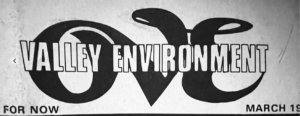 Second, we decided to start a monthly newsletter which we quickly turned into a newspaper called the Ohio Valley Environment or affectionately, the OVE. We freely distributed the OVE throughout SW Indiana, Bloomington, Louisville and Madison regions at the tune of 17,000 a month. We presented balanced environmental health news on most pages but had a hard hitting editorial page that was way before its time. Unlike Synfuel Inquiry and Valley Watch which came a bit later, the OVE was a “for profit” venture that was actually a labor of lOVE.
Second, we decided to start a monthly newsletter which we quickly turned into a newspaper called the Ohio Valley Environment or affectionately, the OVE. We freely distributed the OVE throughout SW Indiana, Bloomington, Louisville and Madison regions at the tune of 17,000 a month. We presented balanced environmental health news on most pages but had a hard hitting editorial page that was way before its time. Unlike Synfuel Inquiry and Valley Watch which came a bit later, the OVE was a “for profit” venture that was actually a labor of lOVE.
We covered stories on toxic waste like the “Valley of the Drums” in Louisville, really thorough coverage of Marble Hill as well as the developments in synfuels and, of course, the proliferation of coal plants and mining in the tri-state. We also ran exclusive stories and interviews with a variety of national figures and studies that apparently were “not worthy” of conventional news coverage.
Those included interviews with the Chair of the Tennessee Valley Authority, David Freemen, the President of the US Synthetic Fuel Corporation, an upstart funded by $88 billion of Federal (taxpayer) money. And, newsmakers like Ralph Nader, Richard Harris (the first director of the Office of Surface Mining), Joel Deckard, the 8th District Congressman and Ernest Sternglass, one of the principal scientists in the Manhattan Project which developed the first nuclear weapons.
Our first expose was about a small socially irresponsible company that operated in Rockport called Barmet. They also had facilities in Livia, KY and Bedford, IN all of which were filthy and dangerous for the people who lived nearby. The plant manager for Rockport was a former Air Force Colonel named John Grunigen. He said something that forever changed the way I would see things.
In my interview with him, I asked him about why he was allowed to operate such a dirty plant without industrial zoning. He said, “Well, young man. Laws are made by the weak to hinder the strong.” I was stunned.
The only thing I had ever heard that came even close to being so anti-democratic was something that a local attorney had said in 1977 as a member of a Chamber committee called the “Task Force For Reasonable Clean Air Standards.” On a local public affairs program addressing the very first health based standards for criteria pollutants like ozone and lead, he seriously said, “The problem with these standards is that they are designed to protect the most sensitive people (meaning those who get sick from dirty air). We will just have to develop some sort of mask for those people to wear.” At the time, there was no viral pandemic that was killing people, he was simply saying in the best “crony capitalist” jargon that economic wealth was more important than public health. And, it is OK to stigmatize some people.
The OVE lasted for three solid years, paid for with affordable advertising and a lot of volunteer effort from writers, artists and distributors but it never really turned a profit. It did have residual impact since it forced the traditional media into covering the topics of environmental health that previously were being ignored or dismissed. That impact lasted at least a decade.
Third, we formed Valley Watch whose purpose was and still is the “protection of public health and the environment of the lower Ohio River Valley.” Unlike the other ventures, Valley Watch was designed to last and be a force for the future in defining the economic course for the region. We would oppose pollution that released toxic chemicals and the facilities that were proposed that would do that. In that effort, we won numerous battles. Barmet was finally forced to close. We beat back all three giant synfuel plants. Marble Hill was forced to shut down before it was completed. A number of coal plants were stopped before they could break ground. Con Agra was stopped from building an ozone producing soybean plant. Yet, another proposal to build a nuclear waste storage site in Kentucky was defeated. Evansville’s own Bristol Myers Squibb was forced to quit using a horrible cancer causing chemical called ethylene oxide to sterilize nipples for their infant formula. Public knowledge about the harmful health impacts of toxic chemicals in the regional environment was heightened.
In that effort, we won numerous battles. Barmet was finally forced to close. We beat back all three giant synfuel plants. Marble Hill was forced to shut down before it was completed. A number of coal plants were stopped before they could break ground. Con Agra was stopped from building an ozone producing soybean plant. Yet, another proposal to build a nuclear waste storage site in Kentucky was defeated. Evansville’s own Bristol Myers Squibb was forced to quit using a horrible cancer causing chemical called ethylene oxide to sterilize nipples for their infant formula. Public knowledge about the harmful health impacts of toxic chemicals in the regional environment was heightened.
We played a significant role in the passage and implementation of Indiana’s solid waste laws and rules which went far in making the disposal of regional waste safer for future generations.
In the twenty-first century, along with colleagues, we stopped several proposed coal plants and the stupid Indiana Gasification proposal in Rockport from being built. We also successfully fought a giant polluting fertilizer in Rockport, too.
We didn’t always win. Our first loss had begun construction prior to our existence-the Rockport power plant.
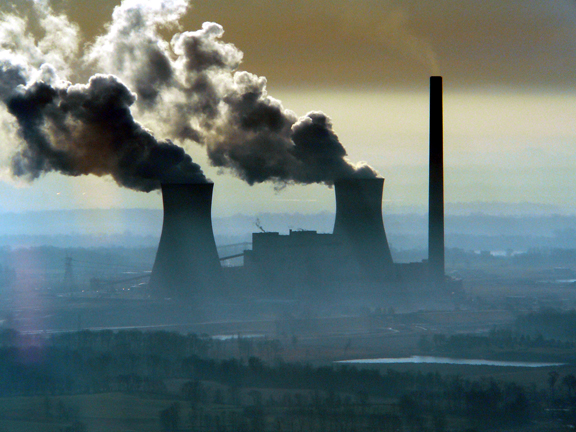
At 2,600 megawatts, the Rockport power plant operated by American Electric Power to serve regions of northeast Indiana and southern Michigan continues to be one of the most polluting plants in the nation. © BlairPhotoEVV
Also, even though we beat back Peabody Energy’s proposal for a massive new coal plant in Muhlenberg County, KY called Thoroughbred, we lost out fight to keep Peabody’s Prairie State plant out of southern Illinois. Now, it is one of the world’s largest CO2 and SO2 emitters.
These battles were long and hard and stressed our entire staff of unpaid volunteers to the limit at times. Marble Hill, Thoroughbred and Indiana Gasification all consumed eight years of our effort. Others, as much as five. But we learned the lesson that if you cannot match money and other resources you MUST rely on perseverance and dedication if you expect to win in the end.
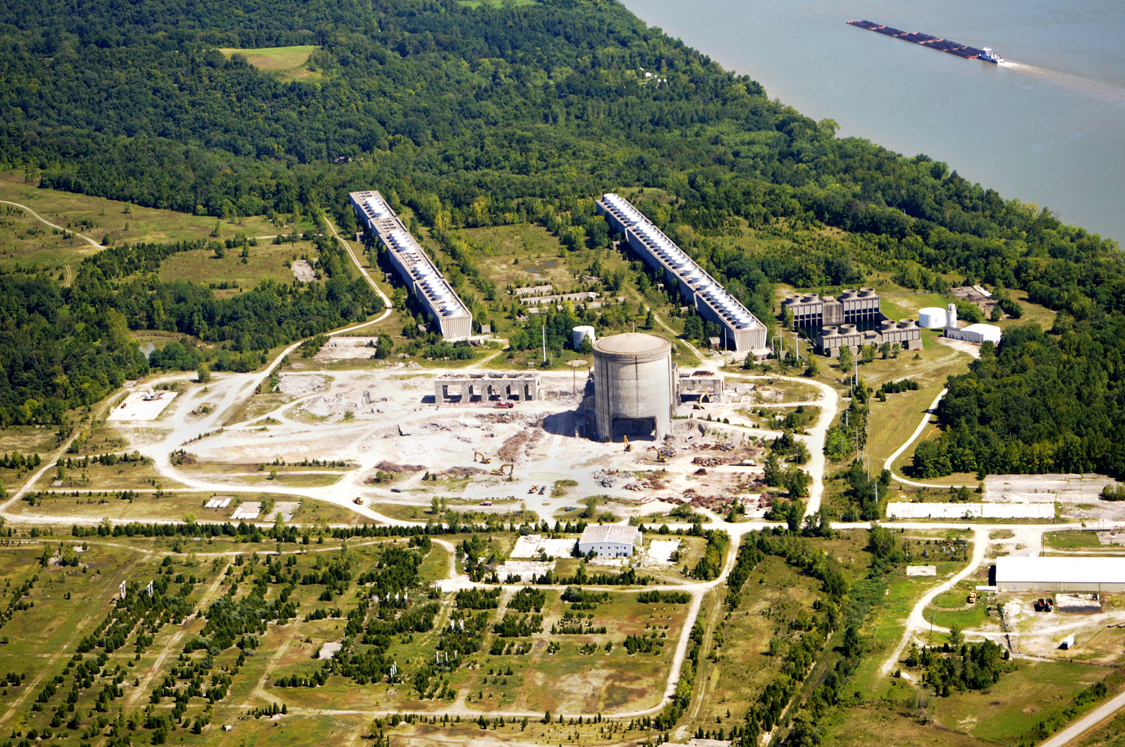
Now, nearly an empty site devoid of life, the Marble Hill nuke sits like a tribute to a technology that was neither safe nor affordable near Madison/Hanover, Indiana. The plant, originally said to cost $700 million in 1973, was shut down in 1984 after having more than $2.7 billion invested but was only 20% complete. Marble Hill was one of Valley Watch’s first victories. Photo © 2010 John Blair.
Our most recent calling is another ridiculous project proposed for Dale, IN, a bucolic community in norther Spencer County. In 2010, a company calling itself, Clean Coal Refining Company sought to build a giant plant to convert coal to diesel fuel and naphtha in Vermillion County, north of Terre Haute. At the time, coal was still king in Indiana and Federal dollars were once again flowing to the dirty fuel. The site was the former US Army nerve gas storage site which consumed hundreds of acres on the banks of the Wabash River.
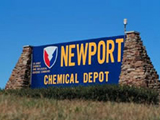
Clean Coal Refineing Corp.’s first shot was at the former US Army’s Chemical Depot located in Newport, IN. Authorities did not renew options after six years because they had had enough “empty promises.”
Vermillion County had been given the land by the Army once the nerve gas was removed and presumably destroyed and they developed a “Redevelopment Commission” to market a large new industrial site. Clean Coal Refining jumped at the chance to get a site, secure and fairly isolated, to build their experimental plant they said would cost $2.5 Billion and create 200 permanent jobs.
The Commission, recently named, Vermillion Rise jumped at the chance to lease 1,500 acres to Clean Coal Refining and gave them three year options which allowed time to design, secure financing, government loan guarantees and find a market for their products. At the end of the three year options, nothing had happened so the Commission gave them an additional three year option. Valley Watch followed their lack of progress but did not see it as much of a threat since nothing was happening.
At the end of the three year options, nothing had happened so the Commission gave them an additional three year option. Valley Watch followed their lack of progress but did not see it as much of a threat since nothing was happening.
Sometime in the middle of the last decade, Vermillion Rise found that the name Clean Coal Refining was a turn-off for other prospects who might wish to locate there. A brand change was required. Riverview Energy arose as a euphemism since it sat on the banks of the Wabash River. Like lipstick on a hog, that was not enough to make the plant viable. By 2016, and still no progress for Riverview, Vermillion said “enough” and told Riverview to pack their bags because the options would not be renewed.
Riverview failed to qualify for Federal Loan Guarantees, nor any state support in marketing their product and people wondered why a firm that was hoping to market a product to the international shipping industry for fuel would locate smack dab in the middle of the Country, far away from seaports that might need their product. But, hey, they still promised jobs.
No longer welcome in Vermillion County, Riverview turned to their ally, a public/private consortium made up of Indiana Government, a few banks and utilities-the Indiana Economic Development Corp. (IEDC) who did not want to give up on the idea of producing diesel from coal. It mattered little if this technology had always failed economically and was essentially experimental, having only been used in petroleum desperate, Nazi Germany during WW2 and recently built in two communist dictatorships, Russia and China where environmental rules are basically nonexistent. No now knows if either of those projects ever reached operational stage.
IEDC told them to check out Spencer County, I suspect because the word was out that Spencer would accept any sort of polluting industry, especially if it had a big price tag and promised construction jobs. After all, Spencer County had already sold its soul to the likes of Barmet, I&M’s Rockport power plant, AK Steel (the nation’s largest toxic water polluter now called Cleveland Cliffs), as well as Indiana Gasification and Ohio Valley Resources fertilizer behemoth, neither of which were built.
Never mind that in 2009, Rockport a town of only 2,000 people already released more toxic chemicals than all the combined toxic pollution released from Atlanta, New York City, Philadelphia, Pittsburgh, Indianapolis, Chicago, Seattle, Los Angeles and San Diego (combined population of 34,000,000). https://enviro.epa.gov/triexplorer/tri_release.chemical
It’s been speculated that the reason Dale was chosen instead of the southern end of the County was because Rockport was already too polluted to meet air quality standards from this giant polluting facility and Dale was just across the line where EPA would claim it took up too much “pollution budget” under their Prevention of Significant Deterioration rules.
In 2017, Riverview chose Dale after IEDC and the LincolnLand Economic Development Corp. (Spencer County’s ED agency) did the advance work to assure an ease of entrance without the public knowing much of anything or being able to object. Word was “it’s a done deal” and will be operating by 2022.
Quickly, the naïve Dale Town Board decided to annex a 512 acre plot north of town, nearly doubling the town’s physical size without much of any knowledge about what they were bringing. In early 2018, the Dale Plan Commission voted in a split decision to give that new site “industrial” zoning to allow a major coal refinery to be built. Full speed ahead was their mantra.
What the Dale Town Board and other Spencer County officials failed to understand were the numerous obstacles that Riverview had thus far ignored. Small items like a construction permit, plant design, and (drum roll) financing. Here it was a full eight years later and the price to build the same plant had not increased one dime. Inflation, ha ha. (Today, sponsors still refuse to acknowledge any sort of inflation in building cost or labor, as if all those building trades unions who claim support for the plant will be willing to work for 2010 wages in 2023).
They also did not understand the spirited opposition from citizens who lived nearby who would be forced to breathe the foul emissions of a coal refinery.
I remember in August of 2017, receiving a call from venerable but novice activist, Mary Hess asking if Valley Watch would be interested in helping her oppose the project. I did my best to assure her that I did not believe there was any chance that this plant would ever get built.
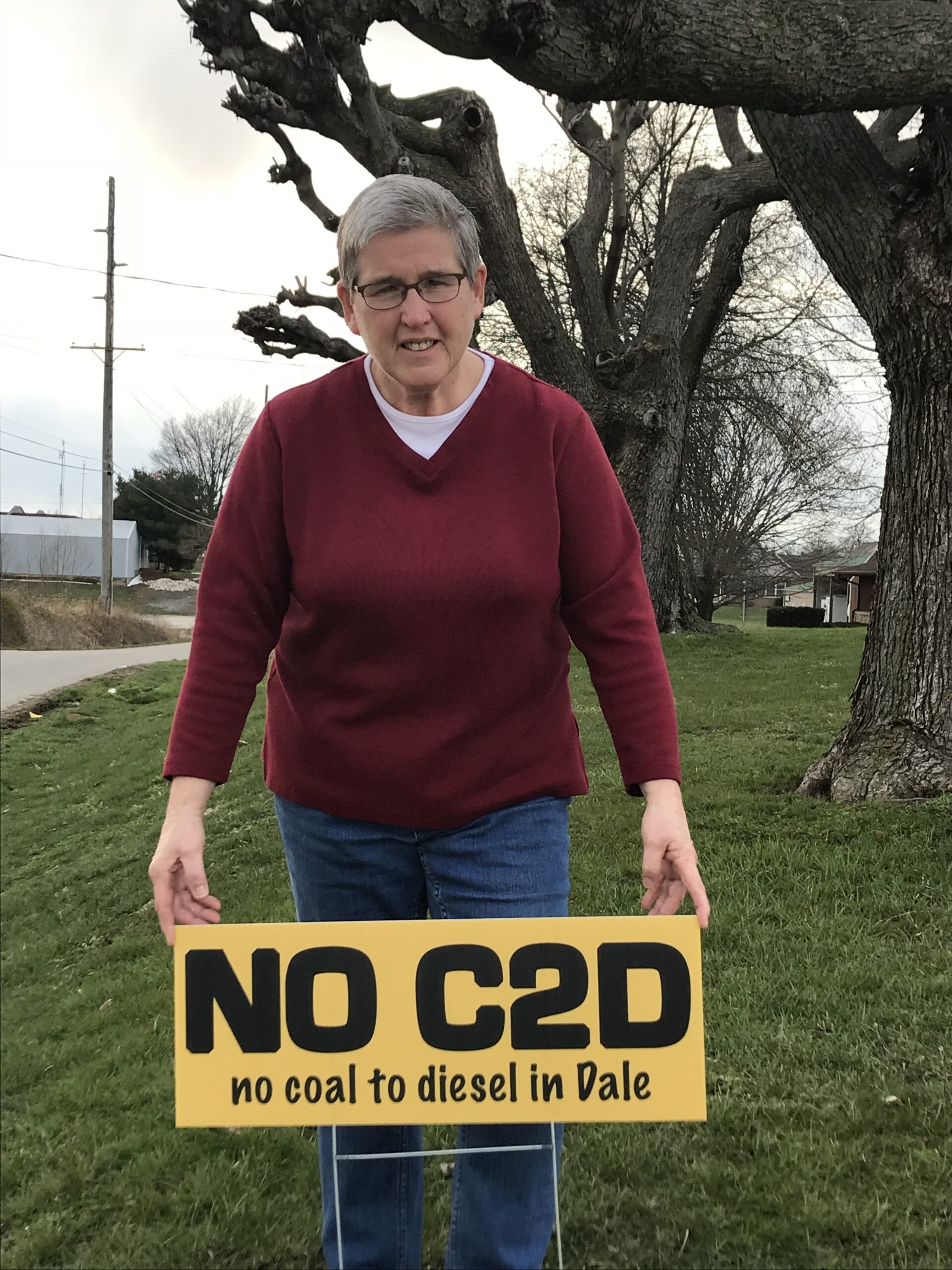
Mary Hess was unwittingly pulled into the battle of her life when Riverview Energy made the anouncement they were planning to build a monstrous coal to diesel refinery less than a mile from her home in Dale, IN. Now, in her fifth year of fighting for her future and those of other Dale residents, she has unselfishly given her all to advocate for environmental health. Here, she places the first of 600 yard signs opposing the plant in her front yard in the Spring of 2018. © BlairPhotoEVV
Why was I so self assured? First, it was clear that coal’s glory days were over. Mines were closing and power plants retiring. Then, there was the financing. Who in their right mind, doing any due diligence would finance such an ill-fated mistake? Already, banks across the globe were divesting from anything coal. And it was unthinkable that anyone with a few extra billion dollars laying around would invest it in such an experiment, even if their management was exemplary.

Riverview Energy President, Gregory Merle whose only previous experience is tutoring high school students to take the SAT test as seen in a screen shot from his site on YouTube.
We became further confident when we did our due diligence on the principals of Riverview Energy. Riverview’s president’s only experience prior to assuming his high office at Riverview was a failed company seeking to tutor high school students to take the SAT test.(Look up “Greg Merle on YouTube).
Sure, we learned Mr. Merle’s father was a coal magnate, with an international reputation marketing coal around the world, but he was certainly not wealthy enough to build a multi-billion dollar experimental plant to serve the shipping industry in the middle of southern Indiana, in a carbon constrained world.
We also gained confidence when we saw their web page and the amateuristic brochure they used to “promote” the venture. That was printed on a poor quality inkjet printer and gave uncredited and specious hyperbole about the need and profitability of the plant. Very unprofessional.
But, the main thing Riverview and their seemingly few supporters failed to recognize was the total and complete dedication and commitment of Dale and other area citizens to stop the plant.
Mary Hess, called a meeting in January, 2018 and asked Valley Watch to speak. I was happy to do so but knew I had to offer a path to victory or else they might leave the meeting overwhelmed. I had an idea-yard signs. “NOC2D-No Coal to Diesel in Dale” would get that done by not only showing opposition from local citizens but also establishing a local grass roots vehicle in which to get involved.
Immediately, we ordered 400 yard signs and through the efforts of people like former Dale Postmaster, Nancy Schorer, we distributed them throughout northern Spencer County and southern DuBois County. Those signs showed that Riverview was not a “done deal.”
Also, out of the January meeting a new group was formed using the same name NOC2D.com.
NOC2D decided to educate the public about the plant and it impacts on the region in health, economic development, and their quality of life. After all, who wants to live near a coal refinery?
During 2018 NOC2D, understanding that possibly more was to come, ultimately changed its name to Southwest Indiana Citizens for Quality of Life and conducted a series of public “forums” beginning in April and running through the fall in churches and high schools across the region.
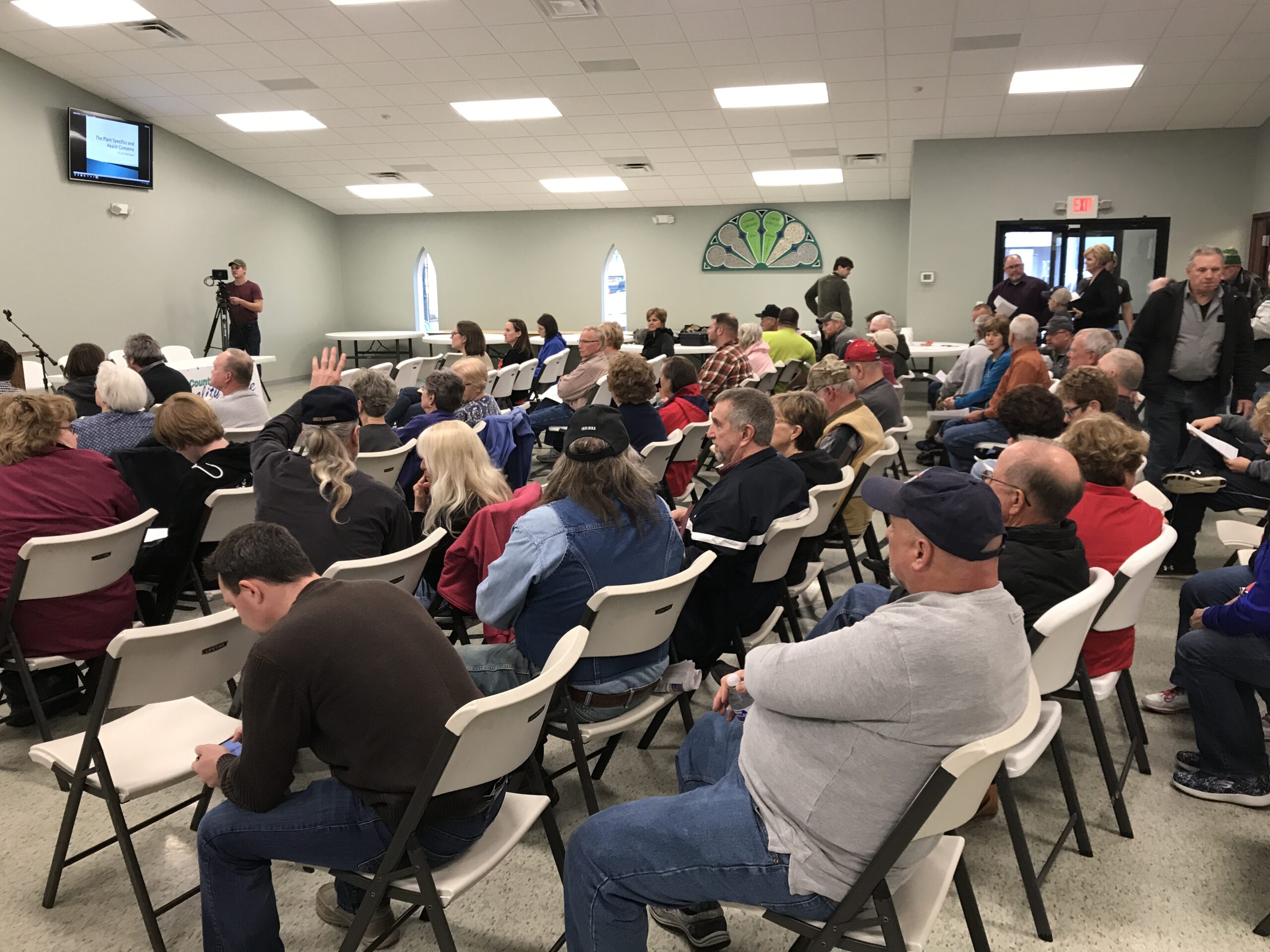
Opponents, seeking far more transparency than Riveriview held its first forum to warn of the dangers of a coal refinery in late April 2018 in Dale. Interest in the community was clearly evident as more than 100 people turned out to understand what was taking place. © BlairPhotoEVV
Those forums had presentations by medical and chemical doctors, teachers and others who did lots more research than those public officials who thought they had an easy path to getting their controversial plant built. This was especially so since Riverview had flown to Switzerland to meet with Governor Holcomb, House Speaker Brian Bosma and other Indiana officials while the Indiana Department of Environmental Management (IDEM) reviewed its permit application.
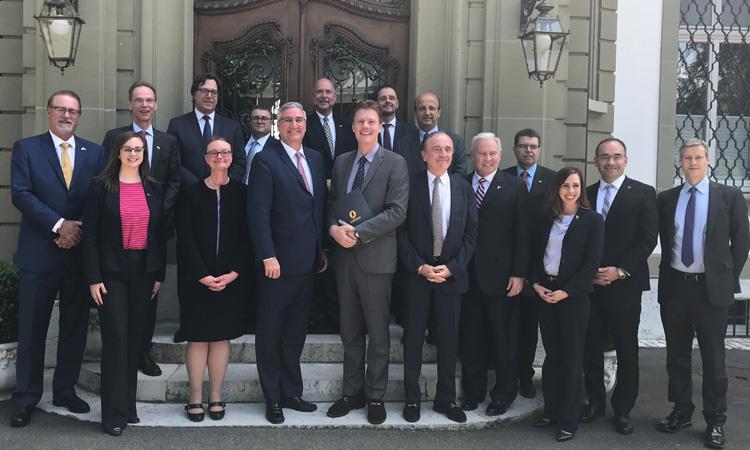
Indiana Governor Holcomb stands next to Riverview Energy President, Greg Merle at the American Embassy in Switzerland in May, 2018 when the indiana Department of Environmental Management was reviewing the Title V and Construction permit for the proposal. Just why is Merle all smiles? Was he reassured that IDEM was going grant him all the approvals he would need to construct? SW Indiana Citzens for Quality of Life have repeatedly reached out to Holcomb’s administration for a meeting to discuss their concerns but to no avail.
Riverview figured all they had to do was pass the low bar of approval from IDEM which claims, to this day that all an applicant must do is dot their “is” and cross the “ts” and they will be issued a permit. With engineering help of the company selling the technology, in December 2018, IDEM issued a draft permit and scheduled a public hearing.
That hearing became kind of infamous with forty-seven area citizens speaking loudly against the proposal with only seven, mostly local government and economic development officials willing to stand for the plant.
Soon, everyone knew that Riverview had run into a juggernaut determined to win and keep their homeland free from any further pollution. Meanwhile Merle and his minions refused to meet with the public and answer the serious questions the opposition was raising and more.
Riverview probably knew that Valley Watch and SWINCQL would not be able to raise enough money to mount anything but a serious grassroots effort to turn the community against them. They failed to contemplate the prolific level of legal assistance that had grown the last two decades to support environmental and health causes. Yes, it took some cajoling and even begging, but Earth Justice heard our pleas for help and joined us in opposing the construction permit for the plant.
 They mounted a serious and legally backed defense, hiring experts to analyze both Riverview’s and IDEM’s assumptions and data. They took depositions from IDEM, Riverview and tech sales company, KBR.
They mounted a serious and legally backed defense, hiring experts to analyze both Riverview’s and IDEM’s assumptions and data. They took depositions from IDEM, Riverview and tech sales company, KBR.
An Environmental Law Judge, in the Office of Environmental Adjudication held a hearing and of course, like they always do, deferred to the findings of IDEM which is in the business of granting permission to pollute. Riverview called that a victory. Our coalition is challenging that decision and went through a hearing in the Marion County Superior Court in August, 2021 and a decision, nearly eight months later, has not been rendered. When that finally happens, it is likely to be appealed to the Indiana Court of Appeals by whichever side loses.
Here is the thing, Riverview still does not have the financing, or even Front End Engineering and Design (FEED), nor have they exercised their options on the 512 acres to begin construction as planting season begins. And they have to do that by June 2022 in order to keep their permit in force.
We remain confident there will be no Coal to Diesel plant in Dale, Indiana and even Spencer County public officials are finally recognizing that five years later. Like Vermillion County finally understood, Riverview is an empty suit offering empty promises.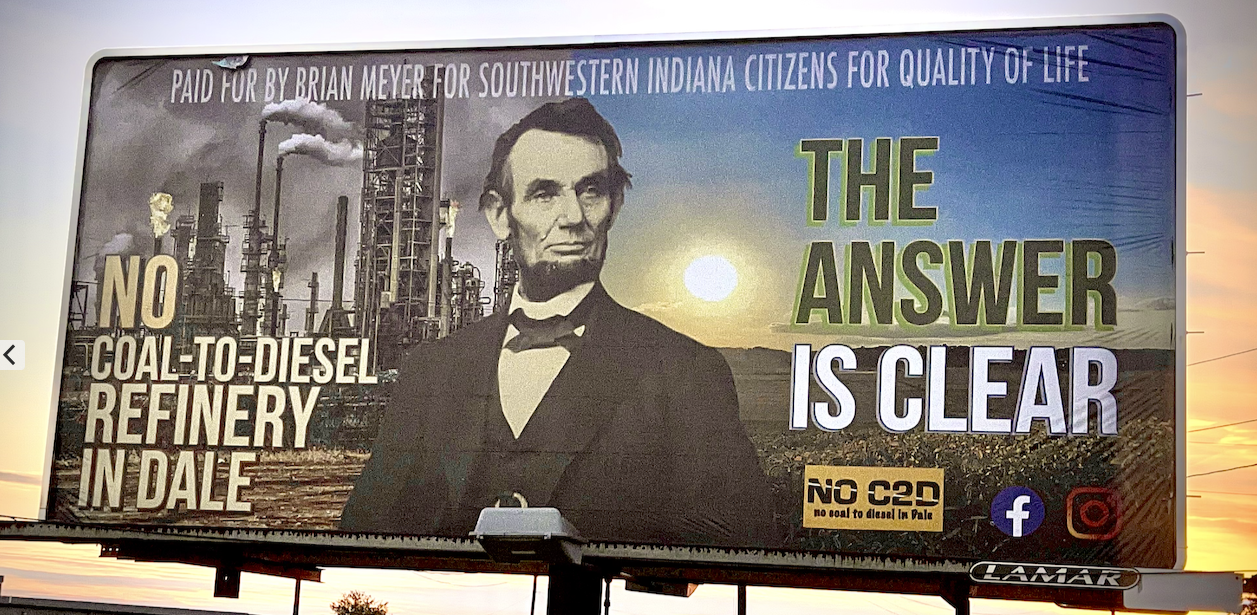
But this is an essay about EarthDay.
I remember that first one in 1970 vividly. I remember massive demonstrations, teach-ins and activists even burying a car to show that the gasoline engine was soon to come to an end.
At that time, there were no environmental rules or laws, just a burning river in Cleveland, a major air pollution event across New York City and the east coast that scared the dickens out of people who worried about their health. There was Rachel Carson and her book Silent Spring that warned the world of the danger of pesticides and the growing chemical environment.
In 1970, teenagers could go into a store and buy cigarettes legally. PCBs one of the first forever chemicals, permeated our manufacturing processes. Nuclear plants were being built under the false notion of “energy too cheap to meter.”
I was a commercial mortgage banker then, financing uninsulated apartments and energy hog shopping centers, many of which no longer exist.
I did not realize it on April 22, 1970, the day I became an environmentalist, but I was not alone. Thousands of my generation heard the call of a better, healthier and less polluted world. We began paying attention to what was happening around us-the toxins, the clear cutting of forests, plastic pollution everywhere. Grassroots groups, took on the mantra “Think Globally, Act Locally” not only in the USA but around the world.
We changed and improved laws. We made demands and we have truly changed the world for the better.
But the wins we have had seem to pale under the threats of Climate Change and Nuclear War, both of which can destroy the planet as we know it and probably eliminate our own species.
Those of us who experienced the first EarthDay are now old. Too many of the new generation have sought to put us out to pasture, often ignoring the knowledge and understanding of economics and ecology we have gained so they can keep their eyes on their phones feeling assured of some sort of future in a plastic covered world that forsakes nature and human dignity. Misinformation permeates any meaningful discussion and political correctness pollutes our ability to even speak.
But one thing I have learned from my fifty-three years of environmental health advocacy is that cynicism cannot win. We must all rise above the cynics, demand an ever-better future that keeps our species and natural world intact.
My twenty-month old first grandchild Rosie Blair deserves a better world. deserves to live a healthy life in a world powered by natural renewable energy, eating food that is safe and wholesome while being able to socialize with the rest of not only humanity but all of the life that exists on what Carl Sagan called our “Pale Blue Dot.”
Perhaps EarthDay 2023 will provide the impetus for that to happen. Will you accept that challenge?
